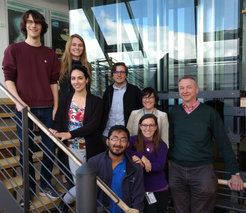Dynamics Group @ MPE

Our research is focused on the dynamics, dark matter, and evolution of nearby galaxies, including our own Milky Way Galaxy. Through detailed studies of nearby systems we aim to understand universal processes that happen over cosmic time.
This `near-field cosmology' approach is particularly apparent in Milky Way studies where the evolutionary history is encoded in the orbits, ages, metallicities, and abundances of stars. Dynamics comes into play because for a meaningful physical description we need to determine the orbits of stars which link stars at different positions and velocities.
Milky Way research is a hot topic because of the recent data from ESA's Gaia satellite mission and the many ground-based surveys already completed or on-going, such as VVV or APOGEE. Our recent research in this area has concentrated on reconstructing the three-dimensional structure and dynamics of the Galactic bulge, bar, and nuclear star cluster.
We are pursuing key issues in the dynamical evolution of bulges and elliptical galaxies such as angular momentum transfer and accretion of subsystems. Using planetary nebulae as tracers, we work on characterizing the kinematics, angular momentum, and dark matter in the outermost halos of early-type galaxies. Many of these tracers were first discovered within the Planetary Nebula Spectrograph (PN.S) project. We are also continuing the development of the Made-to-measure particle method NMAGIC.
The Dynamics Group at the Max-Planck-Institute for Extraterrestrial Physics is led by Ortwin Gerhard. Many of our projects involve interpretation of observational results and are carried out in collaboration with observational groups at MPE and elsewhere. For information about members of the group, current projects, publications, and recent research results see the subsequent pages.
The group webpages are being updated and we hope to have the finished pages soon. You can access the previous webpages here.
